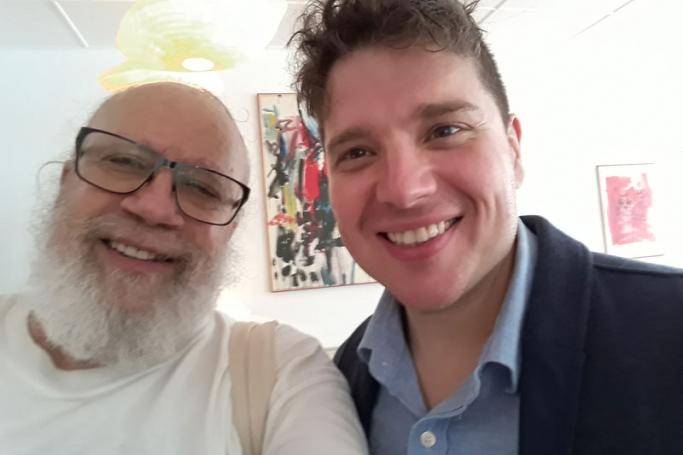Theo Stojanov is a doctoral candidate in Film and Moving Image Studies at Concordia University, where his work focuses on the sociology of cultural production. His research involves a critical examination of the socio-technical aspects of the creative industries and their production practices, policies, and people. He worked closely with Paul Grant of New York University in setting up the debate on film censorship in Myanmar and rest of south-east Asia. Mizzima's Subir Bhaumik caught up with Mr Stojanov on the side-lines of the Memory 2017 film festival.
Q: How should Myanmar's first democratic govt since 1962 go about addressing the new motion picture law that deals with censorship?
A: The conference revealed some of the tensions that are currently surfacing in Myanmar, a country amidst a number of disparate transformations: political, religious, economic, and social reforms are occurring simultaneously, irreversibly, and in an ad hoc fashion. The artistic community’s current challenge is to find new ways around old regulations, and new aesthetics to deal with old anxieties, but based on the presentations and discussions, any viable solution to outdated regulation would have to involve representatives of both the entertainment and the independent filmmaking communities. The friction, as I see it, comes from the difference of opinion between those who see the film as a mass medium intended to please the general public, and those who see it as art or as an instrument of social change. This edition of Memory! Conference, organised by Dr Grant and myself thanks to the generous support of the Memory! Cinema foundation was simply one more step in a critical dialogue that began with the transition to civilian government in 2010, and the terms and functions of censorship in Myanmar continue to be negotiated.
Q: What lessons can it draw from rest of Asia or elsewhere on the issue? What model would suit it the best?
A: Institutionalized censorship functions in similar ways everywhere, but possible solutions were suggested by Dr Saw Tiong Guan, a Malaysian filmmaker and senior lecturer in Law at the University of Malaya. To address the many contemporary functions of film and screen media in general, censorship or rating standards need not only to be clearly articulated but also to offer possibilities for appeal. The compromised impartiality that accompanies entrenched and politicized bureaucracies can be overcome when the law incorporates a requirement to rotate censorship personnel, and eliminates the anonymity behind censorship decisions, making individuals accountable for their decisions. Most importantly, however, this dialogue has to be continually updated and always include the filmmakers themselves.
Q: Since censorship relates to the more fundamental issue of free speech in a democracy, what would be realistic and implementable for Myanmar given the emerging national security issue in Rakhine?
A: I will attempt to answer this question with the disclaimer that I am a film industry researcher and not a political analyst. What is happening in Rakhine state is a tragedy that is now, under democratic rule, visible to the entire world. Conversations about national security should, therefore, include all members of the nation, making decisions together. The difficulty with that, as it appears to an outsider such as myself, is that within the Union of Myanmar there is disunity, and there are many different interests—including foreign ones—bubbling just underneath the surface. Ultimately, at present it is imperative that national security should concern itself with the protection of all peoples on its territory—even the ones not yet officially documented. As long as education, and censorship or rating laws in some way support this vision, freedom of speech is a possibility.
Q: Anything else you like to add, especially the censorship situation in rest of Asia.
A: Censorship throughout Southeast Asia is a variegated affair, beholden to particular customs and cultures that do not fit neatly within a clear-cut North American-style framework, and the conference reflected that in many ways. However, I would like to comment less on particular censorship situations than on specific tendencies of Western representations of censorship in the region in general and in this country in particular. What struck me as worrisome is a tendency on the part of Western media to go after narratives that resonate with the Western world, to hunt for easy trophy stories, so to speak, without establishing a profound engagement with the stories that emerge locally. One good example is that local documentary filmmakers frequently work on topics commissioned by INGOs only to be able to finance with their earnings the stories that they themselves want to tell. This goes for Western journalism as well.
You are viewing the old site.
Please update your bookmark to https://eng.mizzima.com.
Mizzima Weekly Magazine Issue...
14 December 2023
Spring Revolution Daily News f...
13 December 2023
New UK Burma sanctions welcome...
13 December 2023
Spring Revolution Daily News f...
12 December 2023
Spring Revolution Daily News f...
11 December 2023
Spring Revolution Daily News f...
08 December 2023
Spring Revolution Daily News f...
07 December 2023
Diaspora journalists increasin...
07 December 2023












